DDB分布式数据库系统 第三讲 Ddb-L3 design
DD 分布式数据库
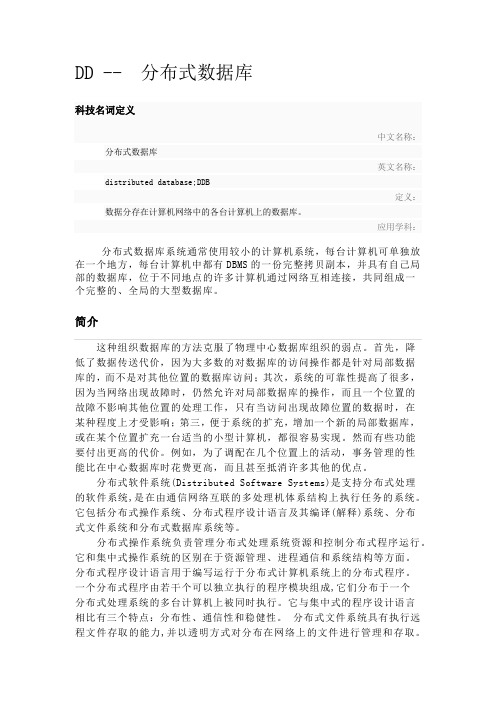
DD -- 分布式数据库科技名词定义中文名称:分布式数据库英文名称:distributed database;DDB定义:数据分存在计算机网络中的各台计算机上的数据库。
应用学科:分布式数据库系统通常使用较小的计算机系统,每台计算机可单独放在一个地方,每台计算机中都有DBMS的一份完整拷贝副本,并具有自己局部的数据库,位于不同地点的许多计算机通过网络互相连接,共同组成一个完整的、全局的大型数据库。
简介这种组织数据库的方法克服了物理中心数据库组织的弱点。
首先,降低了数据传送代价,因为大多数的对数据库的访问操作都是针对局部数据库的,而不是对其他位置的数据库访问;其次,系统的可靠性提高了很多,因为当网络出现故障时,仍然允许对局部数据库的操作,而且一个位置的故障不影响其他位置的处理工作,只有当访问出现故障位置的数据时,在某种程度上才受影响;第三,便于系统的扩充,增加一个新的局部数据库,或在某个位置扩充一台适当的小型计算机,都很容易实现。
然而有些功能要付出更高的代价。
例如,为了调配在几个位置上的活动,事务管理的性能比在中心数据库时花费更高,而且甚至抵消许多其他的优点。
分布式软件系统(Distributed Software Systems)是支持分布式处理的软件系统,是在由通信网络互联的多处理机体系结构上执行任务的系统。
它包括分布式操作系统、分布式程序设计语言及其编译(解释)系统、分布式文件系统和分布式数据库系统等。
分布式操作系统负责管理分布式处理系统资源和控制分布式程序运行。
它和集中式操作系统的区别在于资源管理、进程通信和系统结构等方面。
分布式程序设计语言用于编写运行于分布式计算机系统上的分布式程序。
一个分布式程序由若干个可以独立执行的程序模块组成,它们分布于一个分布式处理系统的多台计算机上被同时执行。
它与集中式的程序设计语言相比有三个特点:分布性、通信性和稳健性。
分布式文件系统具有执行远程文件存取的能力,并以透明方式对分布在网络上的文件进行管理和存取。
数据库原理和应用基本知识点和习题

数据库原理及应用基本知识点与习题目录第1章数据库系统概述 (1)1.1 基本知识点 (1)1.2 习题1 (1)第2章数据模型 (4)2.1 基本知识点 (4)2.2 习题2 (4)第3章数据库系统的体系结构 (7)3.1 基本知识点 (7)3.2 习题3 (7)第4章关系数据库方法 (10)4.1 基本知识点 (10)4.2 习题4 (10)第5章关系数据库的结构化查询语言SQL (16)5.1 基本知识点 (16)5.2 习题5 (17)第6章关系模式的规范化理论 (27)6.1 基本知识点 (27)6.2 习题6 (27)第7章数据库设计 (30)7.1 基本知识点 (30)7.2 习题7 (30)第8章数据库保护 (16)8.1 基本知识点 (38)8.2 习题8 (38)第9章 Microsoft SQL SERVER 2000 (41)9.1 基本知识点 (41)9.2 习题9 (41)第10章 和数据库开发技术 (43)10.1 基本知识点 (43)10.2 习题10 (43)第11章分布式数据库系统 (44)11.1 基本知识点 (44)11.2 习题11 (44)第12章数据仓库与数据挖掘 (46)12.1 基本知识点............................................... 错误!未定义书签。
12.2 习题12 (46)第13章XML数据库 (48)13.1 基本知识点 (48)13.2 习题13 (48)第1章数据库系统概述1.1 基本知识点本章先介绍数据库技术的产生与发展,然后介绍数据库的基本概念和数据库系统的特点。
本章的学习重点是数据库的基本概念和基本知识的把握,为后续各章节的学习打下扎实的基础。
(1)数据库技术的产生与发展人工管理阶段、文件系统阶段、数据库系统阶段和高级数据库技术阶段等各阶段的特点。
(2)数据库系统基本概念DB、DBMS和DBS的定义。
引跑科技DBOne分布式数据库系统技术白皮书

多应用存储模型
内嵌的多应用存储模型,用不同的模型来存结构化、半结构化和空间数据, 支持记录级别安全控制
数据访问层 实现数据逻辑存储到物理数据库的映射,支持多种拆分策略 支持并行查询,及结果的合并、分组、排序等操作 提供高扩展支持,实现数据在物理数据库间的再分配 实现高可靠性,不同拆分数据库间实现冗余备份 支持 Transaction 内置负载均衡策略 自动数据分片
©引跑科技,版权所有
DBOne 分布式数据库系统技术白皮书
15
节点发现和负载均衡原理图一
节点发现和负载均衡原理图二
©引跑科技,版权所有
DBOne 分布式数据库系统技术白皮书
16
GISOne 云空间数据库具有以下几个重要功能:
空间扩展
对指定应用执行 GIS 扩展
智能水平压缩
智能水平扩展原理图三
©引跑科技,版权所有
DBOne 分布式数据库系统技术白皮书
11
智能水平扩展压缩图一
智能水平扩展压缩图二
©引跑科技,版权所有
DBOne 分布式数据库系统技术白皮书
12
智能水平压缩原理图三
高可用性 可以配置 Shard 备份的数量(例如 Replica=2) 当某些服务器出现故障,其他服务器可以自动接管负载,并且重新 分配 Shard 备份
DBOne 分布式 NoSql 数据库关键功能特性如下:
支持通用的 JSON 半结构化数据类型 “Key-Value”构成的集合,类似 Map “Value”构成的有序列表,类似 Array
支持所有通用语法 值、数组(有序) 、对象(无序) 、运算符 操作符、函数、索引
数据仓库设计ppt课件

¨ 元数据库是数据仓库的灵魂。没有元数据库, 用户就无法对数据仓库数据进行良好的定义、组 织和管理。
37
变电站电气主接线是指变电站的变压器、输电线路怎样与电力系统相连接,从而完成输配电任务。变电站的主接线是电力系统接线组成中一个重要组成部分
39
变电站电气主接线是指变电站的变压器、输电线路怎样与电力系统相连接,从而完成输配电任务。变电站的主接线是电力系统接线组成中一个重要组成部分
¨ (2)数据仓库与业务处理系统的接口设计 在确定了数据仓库的数据源以后,就需要考虑
数据仓库与作为数据源的业务处理系统的接口设计。
40
变电站电气主接线是指变电站的变压器、输电线路怎样与电力系统相连接,从而完成输配电任务。变电站的主接线是电力系统接线组成中一个重要组成部分
¨ (1)拷贝中间件,主要有如下4种: ¨ A.代码发生器。 ¨ B.数据复制工具。 ¨ C.数据泵。 ¨ D.广义数据获取工具和设备。
44
变电站电气主接线是指变电站的变压器、输电线路怎样与电力系统相连接,从而完成输配电任务。变电站的主接线是电力系统接线组成中一个重要组成部分
¨ (2)用于数据库访问的网关中间件:主要用于解 决数据仓库与数据源和客户端之间的网络协议不 同所造成的数据传输困难的问题。
3.2.2 数据仓库接口与中间件设计
1.数据仓库的数据源确定以及与业务处理系统接口 的设计
¨ (1)数据仓库的数据源确定 ¨ 要为数据仓库从数据源中抽取为管理决策分析
所使用的数据源,首先要对所抽取的数据源进行 正确的定义。数据源的定义要确定数据仓库主题 所需各数据源的详细情况,包括数据源所在计算 机平台、拥有者、数据结构、使用该数据源的处 理过程、数据仓库更新计划等。
分布式数据库系统(DDBS)概述.
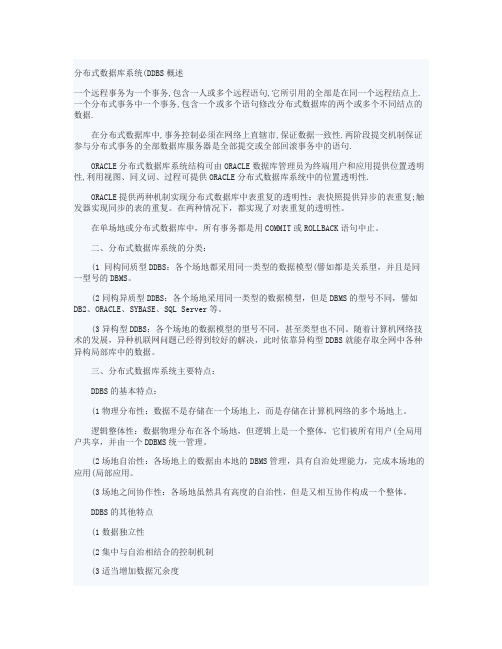
分布式数据库系统(DDBS概述一个远程事务为一个事务,包含一人或多个远程语句,它所引用的全部是在同一个远程结点上.一个分布式事务中一个事务,包含一个或多个语句修改分布式数据库的两个或多个不同结点的数据.在分布式数据库中,事务控制必须在网络上直辖市,保证数据一致性.两阶段提交机制保证参与分布式事务的全部数据库服务器是全部提交或全部回滚事务中的语句.ORACLE分布式数据库系统结构可由ORACLE数据库管理员为终端用户和应用提供位置透明性,利用视图、同义词、过程可提供ORACLE分布式数据库系统中的位置透明性.ORACLE提供两种机制实现分布式数据库中表重复的透明性:表快照提供异步的表重复;触发器实现同步的表的重复。
在两种情况下,都实现了对表重复的透明性。
在单场地或分布式数据库中,所有事务都是用COMMIT或ROLLBACK语句中止。
二、分布式数据库系统的分类:(1 同构同质型DDBS:各个场地都采用同一类型的数据模型(譬如都是关系型,并且是同一型号的DBMS。
(2同构异质型DDBS:各个场地采用同一类型的数据模型,但是DBMS的型号不同,譬如DB2、ORACLE、SYBASE、SQL Server等。
(3异构型DDBS:各个场地的数据模型的型号不同,甚至类型也不同。
随着计算机网络技术的发展,异种机联网问题已经得到较好的解决,此时依靠异构型DDBS就能存取全网中各种异构局部库中的数据。
三、分布式数据库系统主要特点:DDBS的基本特点:(1物理分布性:数据不是存储在一个场地上,而是存储在计算机网络的多个场地上。
逻辑整体性:数据物理分布在各个场地,但逻辑上是一个整体,它们被所有用户(全局用户共享,并由一个DDBMS统一管理。
(2场地自治性:各场地上的数据由本地的DBMS管理,具有自治处理能力,完成本场地的应用(局部应用。
(3场地之间协作性:各场地虽然具有高度的自治性,但是又相互协作构成一个整体。
DDBS的其他特点(1数据独立性(2集中与自治相结合的控制机制(3适当增加数据冗余度(4事务管理的分布性四、分布式数据库系统的优点:(1更适合分布式的管理与控制。
[计算机互联网]数据库系统教程——施伯乐第三版PDF5
![[计算机互联网]数据库系统教程——施伯乐第三版PDF5](https://img.taocdn.com/s3/m/1dce278c50e79b89680203d8ce2f0066f533649c.png)
规划、研制、实现、投入运行后的维护直到它被新的软件所取代而停止使用规划、需求分析、概念设计、逻辑设计、物理设计、实现、运行维护●●● 武汉大学《数据库原理》课题组9 5.4 5.4 需求分析需求分析一、需求分析的任务1信息要求2处理要求3功能要求4企业环境特征二、需求分析的方法1. 需求信息的收集概念设计确定系统的边界了解组织机构情况调查各部门业务活动情况明确用户的需求SA法DFD DD 用户、分析员、设计员步骤是武汉大学《数据库原理》课题组10 5.4 5.4 需求分析需求分析2. 需求信息的分析整理用数据流图和数据字典描述。
三、数据流图DFD—Data Flow Diagram DFD用来表示各业务流程中涉及到的数据和处理关系数据流图的基本成分表示同类数据的存放处常指数据文件表示对数据的处理表示不同处理过程之间传递的数据表示数据的发送者和接收者文件名操作对象武汉大学《数据库原理》课题组11 5.4 5.4 需求分析需求分析1.1 注册1.2 选课1.3 分配专业要求学习情况入校学生通知单毕业学生派遣单课表成绩表四、数据字典: 是DBS中各类数据描述的集合。
1.作用是建立和维护DBS的一种工具。
快速查询对象掌握系统运行情况2.内容DBS中1所有对象及其属性的描述信息2对象之间关系的描述信息。
3所有对象、属性的自然语言含义4数据字典变化的历史记录。
武汉大学《数据库原理》课题组12 5.4 5.4 需求分析需求分析3数据字典与DBMS的关系1结合式数据字典DBMS和数据字典融合在一起2独立式数据字典数据字典软件包不依附DBMS 独立存在。
5.数据库应用系统的数据字典包括数据项数据结构数据流数据存储处理过程4数据字典的访问1与人的接口:通过DBMS提供的数据字典访问工具实现对系统数据的访问。
2与软件接口:通过DBMS的应用程序接口API 实现对数据字典信息的访问和处理。
武汉大学《数据库原理》课题组13 5.4 5.4 需求分析需求分析例下图给出了某机器制造厂的零配件采购子系统的数据流图。
DDB分布式数据库系统 第三讲 Ddb-L3 design
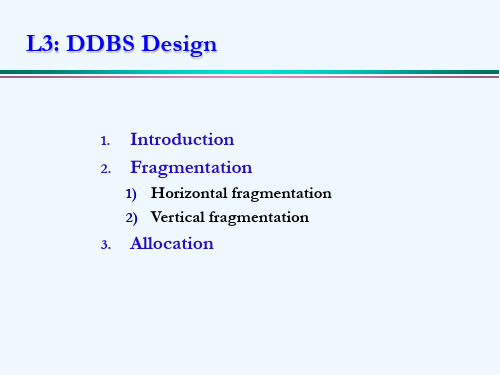
the distribution of DDBMS software distribution of applications
We concentrate on distribution of data.
The distribution of DDBMS and applications are given a
priority.
Dimensions of the Problem
Access pattern behavior
Static Data Data + Program Level of knowledge Partial Information Dynamic Complete Information
Correctness Criteria
Completeness -no loss of data.
Decomposition of relation R into fragments R1, R2, …, Rn
is complete if and only if each data item in R can also be found in some Ri .
How much to fragment
Too little -too much of irrelevant data access. Too much -too much processing cost. Need to find suitable level of fragmentation.
Level of sharing
Design Approaches
Top-Down
Design systems from scratch Homogeneous systems
第九章_分布式数据库

26
习 题:
P.215
9.3 9.7 ---- 9.9 9.12---9.15
27
DB1 计算机1 □ T1 □ T2 □ T3
DB2 计算机2
场地1 场地1:
场地2 场地2:
□ T1 □ T2 □ T3
通信网络
DB3 计算机3
场地3
□ T1 □ T2 □ T3
4
分布式数据库的数据分散在各个场地上,但这些数据 在逻辑上都是一个整体,如同一个集中式数据库。 分布式数据库包括:局部数据库和全局数据库两个概念。 分布式数据库的“逻辑整体性”特点: 局部数据库是从各个场地的角度;
24
DDBMS的一般功能结构:
用户查询
查询处理模块
查询分析
需要的数据
完整性 处理模块
数据定位
系统 DD
优化算法 局部处 理命令 LDBMS 分布策略 调度处理模块
实际的数据 可靠性 处理模块 错误 对网络的 监视信息
数据 DB
计算机
网 络
25
§5
自学:
分布式查询处理
查询代价的估算方法
具有半联接的优化策略
全局数据库是从整个系统角度出发研究问题。
5
二、分布式数据库系统(DDBS)的定义
定义一:DDBS是物理上分散、逻辑上集中的数据库系统,系统中 的数据分布存放在计算机网络的不同场地的计算机中,每一场地 都有自治处理(即独立处理)能力并能完成局部应用,而每一场 地也参与(至少一种)全局应用,程序通过网络通信子系统执行 全局应用。
人员易于管理,便于完成大型任务;
数据集中管理,减少了数据冗余; 较高的数据独立性。
随着数据库应用的不断发展,规模不断扩大,集中式系统存在如下 缺点: 大型DBS的设计和操作较复杂;
全国计算机等级考试《三级数据库技术》复习全书核心讲义历年真题详解

最新资料,WORD格式,可编辑修改!目录第一部分备考指南............................................................第1章考试概述..........................................................第2章复习技巧.......................................................... 第二部分核心讲义............................................................第1章数据库应用系统开发方法............................................第2章需求分析..........................................................第3章数据库结构设计....................................................第4章数据库应用系统功能设计与实施......................................第5章UML与数据库应用系统...............................................第6章高级数据查询......................................................第7章数据库及数据库对象................................................第8章数据库后台编程技术................................................第9章安全管理..........................................................第10章数据库运行维护与优化.............................................第11章故障管理.........................................................第12章备份与恢复数据库.................................................第13章大规模数据库架构.................................................第14章数据仓库与数据挖掘............................................... 第三部分历年真题及详解......................................................全国计算机等级考试《三级数据库技术》真题精选(一)........................全国计算机等级考试《三级数据库技术》真题精选(二)........................ 第四部分模拟试题及详解......................................................全国计算机等级考试《三级数据库技术》模拟试题及详解(一)..................全国计算机等级考试《三级数据库技术》模拟试题及详解(二)..................第一部分备考指南第1章考试概述一、考试简介全国计算机等级考试(National Computer Rank Examination,简称NCRE),是经原国家教育委员会(现教育部)批准,由教育部考试中心主办,面向社会,用于考查应试人员计算机应用知识与技能的全国性计算机水平考试体系。
数据库原理及应用基本知识点与习题
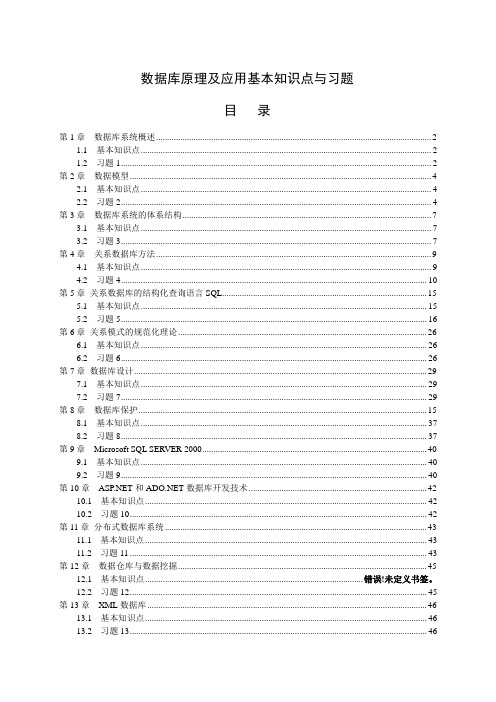
数据库原理及应用基本知识点与习题目录第1章数据库系统概述 (2)1.1 基本知识点 (2)1.2 习题1 (2)第2章数据模型 (4)2.1 基本知识点 (4)2.2 习题2 (4)第3章数据库系统的体系结构 (7)3.1 基本知识点 (7)3.2 习题3 (7)第4章关系数据库方法 (9)4.1 基本知识点 (9)4.2 习题4 (10)第5章关系数据库的结构化查询语言SQL (15)5.1 基本知识点 (15)5.2 习题5 (16)第6章关系模式的规范化理论 (26)6.1 基本知识点 (26)6.2 习题6 (26)第7章数据库设计 (29)7.1 基本知识点 (29)7.2 习题7 (29)第8章数据库保护 (15)8.1 基本知识点 (37)8.2 习题8 (37)第9章Microsoft SQL SERVER 2000 (40)9.1 基本知识点 (40)9.2 习题9 (40)第10章和数据库开发技术 (42)10.1 基本知识点 (42)10.2 习题10 (42)第11章分布式数据库系统 (43)11.1 基本知识点 (43)11.2 习题11 (43)第12章数据仓库与数据挖掘 (45)12.1 基本知识点................................................................................................... 错误!未定义书签。
12.2 习题12 (45)第13章XML数据库 (46)13.1 基本知识点 (46)13.2 习题13 (46)第1章数据库系统概述1.1 基本知识点本章先介绍数据库技术的产生与发展,然后介绍数据库的基本概念和数据库系统的特点。
本章的学习重点是数据库的基本概念和基本知识的把握,为后续各章节的学习打下扎实的基础。
(1)数据库技术的产生与发展人工管理阶段、文件系统阶段、数据库系统阶段和高级数据库技术阶段等各阶段的特点。
第九讲分布式地图数据库ppt课件

分布式数据库系统的模式结构
经营者提供商品或者服务有欺诈行为 的,应 当按照 消费者 的要求 增加赔 偿其受 到的损 失,增 加赔偿 的金额 为消费 者购买 商品的 价款或 接受服 务的费 用
三、分布式数据库系统——六层模式结构
全全局局外外模模式式 全全局局外外模模式式 全全局局外外模模式式
映象1
全局DSBM
(7)适当数据冗余
(8)全局一致性、可串 行性和可恢复性
服务器2
网络
DB2
客 户 ┊
服务器3 DB3
客…户┉
客户…┉
分布式数据库系统
经营者提供商品或者服务有欺诈行为 的,应 当按照 消费者 的要求 增加赔 偿其受 到的损 失,增 加赔偿 的金额 为消费 者购买 商品的 价款或 接受服 务的费 用
一、分布式数据库系统——优点
经营者提供商品或者服务有欺诈行为 的,应 当按照 消费者 的要求 增加赔 偿其受 到的损 失,增 加赔偿 的金额 为消费 者购买 商品的 价款或 接受服 务的费 用
一、分布式数据库系统概述
DB1
DB2
只不支支持持全局局部应应用用 DB3
后台服务器1 后台服务器2 后台服务器3
网络 前台客户机
客户
客户
服务器3 DB3
客…户┉
客户…┉
分布式数据库系统
经营者提供商品或者服务有欺诈行为 的,应 当按照 消费者 的要求 增加赔 偿其受 到的损 失,增 加赔偿 的金额 为消费 者购买 商品的 价款或 接受服 务的费 用
一、分布式数据库系统——特点
(5)数据独立性
DB1
(6)集中与自治相结合的控服制务结器构1
经营者提供商品或者服务有欺诈行为 的,应 当按照 消费者 的要求 增加赔 偿其受 到的损 失,增 加赔偿 的金额 为消费 者购买 商品的 价款或 接受服 务的费 用
分布式课后习题答案

第一章分布式数据库系统概述请用自己的语言定义下列分布式数据库系统中的术语:(1)全局/局部数据:(详见课本第9页所谓的局部数据是指……;所谓的全局数据是指……)(2)全局/局部用户(应用):(3)全局/局部DBMS:(4)全局/局部DB:(5)全局外模式:(详见课本第13页)由全局用户视图组成,是全局概念模式的子集。
(6)全局概念模式:(详见课本第13页)定义分布式数据库系统中所有数据的整体逻辑结构,是全局应用的公共数据视图。
(7)分片模式:(详见课本第13页)是全局数据整体逻辑结构分割后的局部逻辑结构,是DDBS 的全局数据的逻辑划分视图.(8)分配模式:(详见课本第13页)用于根据选定的数据总体分配方案,定义各片段的物理存放地点.(9)局部概念模式:(详见课本第13-14页)是全局概念模式被分片和分配到局部场地上的映像的逻辑结构及特征的描述,是全局概念模式的子集。
其逻辑结构与局部DBMS所支持的数据模型有关,当全局数据模型与局部数据模型不同时,局部概念模式还应包括数据模型转换的描述。
(10)局部内模式:描述局部概念模式涉及的数据在局部DBMS中的物理结构及物理存储细节,完全与非分布式系统相同。
1.2采用分布式数据库系统的主要原因是什么?(P1)1.3分布式数据库系统可分为哪些类?(课件第1章。
课本P6,7,8)1.4什么是分布式数据库系统?它具有哪些主要特点?怎么样区别分布式数据库系统与只提供远程数据访问功能的网络数据库系统?(分布式数据库系统的定义、特点详见课件第1.课本P6)1.5分布式DBMS具有哪些集中式DBMS不具备的功能?(课件第1章。
课本P15)用自己的语言解析“什么时候需要进行数据分片和数据复制”?(课本第10,11页)式数据库系统中,为什么要对数据进行分片?什么是关系的片段?关系的片段有哪些主要类型?(课本第9-10页。
数据分片是指数据存放单位不是全部关系,而是关系的一个片段。
DDB分布式数据库系统第一讲Ddb-L1introduction

Transparency
Transparency refers to separation of the higher-level semantics of a system from lower-level implementation details. From data independence in centralized DBMS to fragmentation transparency in DDBMS. Issues
DBMS ones
Cost
More hardware, software and people costs
Distribution of control
Problems of synchronization and coordination to maintain data
consistency
What is not a Distributed Database System?
A DDBS is not a ``collection of files'' that can be individually stored at each node of a computer network
The technology of computer networks, promotes a mode of work that goes against all centralization efforts and facilitates distributed computing Distributed database system technology is the union of what appear to be diametrically opposed approaches to data processing: Database System, Computer Network technologies A database system aims at integrating the operational data of an enterprise, and to provide a centralized and controlled access to that data
分布式数据库的系统结构

29
❖重名的数据在层次结构中有不同的 路径(path),只要在数据名前加 路径名,就可以区分不同证:
❖同一系统各结点不重名, ❖同一结点用户不重名, ❖同一用户所建数据不重名。
❖ 物理上分布,逻辑上集中。
❖ 物理与逻辑上都分布。
第一种比较成熟,也比较基本,所 以我们以物理上分布,逻辑上集中类 型的分布式数据库系统为主,介绍分 布式数据库系统的一些基本原理和结 构。物理上分布,逻辑上集中的 DDBMS体系结构如下图:
1
2
❖注意: ❖ 1、 2、每个结点都有LDBMS和分布
❖这种方式与扩展集中式目录管理相比, 减少局部更新次数。
24
❖不管所用目录曾更新过与否,均指 明查询所依据的目录版本号。
❖有的系统发送子查询时不附目录版 本号。执行节点使用缓存目录时主 动与集中目录核对版本号,不对则 自动更新目录数据。
❖但有时因数据目录的更新可能引起 须重新拟定执行计划(如文件结构 的变化等)。
❖3.分布式并发控制。
❖ Distributed concurrency control
❖4、分布式恢复问题。
❖ Distributed recover problems
❖本章将讨论上述问题
13
§2.1 distribution and management of datalog
(directory)
❖数据目录只有一份,存于一个结点, 所有结点都要通过该结点访问数据目 录。
❖特点:管理简单;缺点:数据目录是 频繁访问的对象,通信开销大,容易 形成系统瓶颈,效率下降。
17
❖注意管理集中目录的计算机工作 方式是文件服务器而非c/s方式。
分布式数据库复习要点
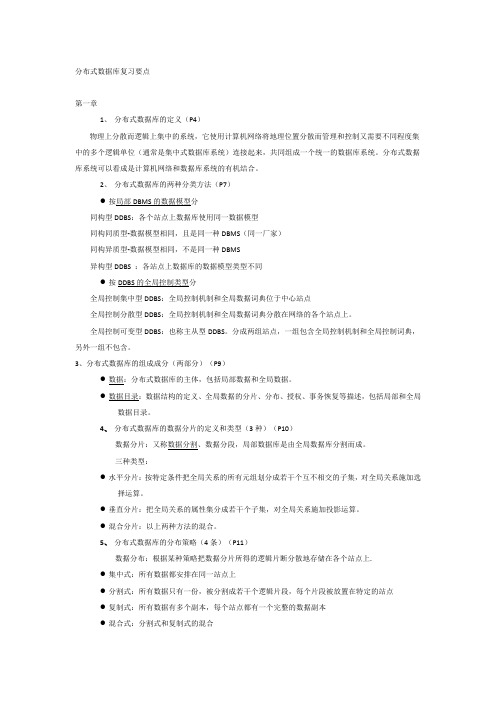
分布式数据库复习要点第一章1、分布式数据库的定义(P4)物理上分散而逻辑上集中的系统,它使用计算机网络将地理位置分散而管理和控制又需要不同程度集中的多个逻辑单位(通常是集中式数据库系统)连接起来,共同组成一个统一的数据库系统。
分布式数据库系统可以看成是计算机网络和数据库系统的有机结合。
2、分布式数据库的两种分类方法(P7)●按局部DBMS的数据模型分同构型DDBS:各个站点上数据库使用同一数据模型同构同质型-数据模型相同,且是同一种DBMS(同一厂家)同构异质型-数据模型相同,不是同一种DBMS异构型DDBS :各站点上数据库的数据模型类型不同全局控制集中型DDBS:全局控制机制和全局数据词典位于中心站点全局控制分散型DDBS:全局控制机制和全局数据词典分散在网络的各个站点上。
全局控制可变型DDBS:也称主从型DDBS。
分成两组站点,一组包含全局控制机制和全局控制词典,另外一组不包含。
3、分布式数据库的组成成分(两部分)(P9)●数据:分布式数据库的主体,包括局部数据和全局数据。
●数据目录:数据结构的定义、全局数据的分片、分布、授权、事务恢复等描述,包括局部和全局数据目录。
4、分布式数据库的数据分片的定义和类型(3种)(P10)数据分片:又称数据分割、数据分段,局部数据库是由全局数据库分割而成。
三种类型:●水平分片:按特定条件把全局关系的所有元组划分成若干个互不相交的子集,对全局关系施加选择运算。
●垂直分片:把全局关系的属性集分成若干个子集,对全局关系施加投影运算。
●混合分片:以上两种方法的混合。
5、分布式数据库的分布策略(4条)(P11)数据分布:根据某种策略把数据分片所得的逻辑片断分散地存储在各个站点上.●集中式:所有数据都安排在同一站点上●分割式:所有数据只有一份,被分割成若干个逻辑片段,每个片段被放置在特定的站点●复制式:所有数据有多个副本,每个站点都有一个完整的数据副本●混合式:分割式和复制式的混合6、分布式数据库的模式结构(P13)分四层:●全局外层:全局外模式---全局应用的用户视图。
分布式数据库系统知识点及习题

第9章分布式数据库系统9.1 基本内容分析9.1.1 本章重要概念(1)分布计算的三种形式:处理分布,数据分布,功能分布。
(2)C/S系统,工作模式,技术特征,体系结构,两层、三层、多层C/S结构。
(3)DDBS的定义、特点、优点、缺点和分类;分布式数据存储的两种形式(分片和分配)。
(4)DDB的体系结构:六层模式,分布透明性的三个层次,DDBS的组成,DDBMS的功能和组成。
(5)分布式查询处理的查询代价,基于半联接的优化策略,基于联接的优化策略。
(6)分布式数据库的并发控制和恢复中出现的问题,以及处理机制。
9.1.2 本章的重点篇幅(1)两层、三层、多层C/S结构。
(教材P365-367)(2)分布式数据存储:分片和分配。
(教材P375-377)(3)DDB的体系结构。
(教材P378的图9.10,P381的图9.12)(4)基于半联接的执行示意图。
(教材P389的图9.17)9.2 教材中习题9的解答9.1 名词解释·集中计算:单点数据和单点处理的方式称为集中计算。
·分布计算:随着计算机网络技术的发展,突破集中计算框架,DBMS的运行环境逐渐从单机扩展到网络,对数据的处理从集中式走向分布式、从封闭式走向开放式。
这种计算环境称为分布计算。
·处理分布:指系统中处理是分布的,数据是集中的这种情况。
·数据分布:指系统中数据是分布的,但逻辑上是一个整体这种情况。
·功能分布:将计算机功能分布在不同计算机上执行,譬如把DBMS功能放在服务器上执行,把应用处理功能放在客户机上执行。
·服务器位置透明性:指C/S系统向客户提供服务器位置透明性服务,用户不必知道服务器的位置,就可以请求服务器的服务。
·集中式DBS:所有工作都由一台计算机完成,这种DBS称为集中式DBS。
·DDBS:是物理上分散逻辑上集中的DBS,每一场地既能完成局部应用又能完成全局应用,这种系统称为DDBS。
DDB网络方案的设计
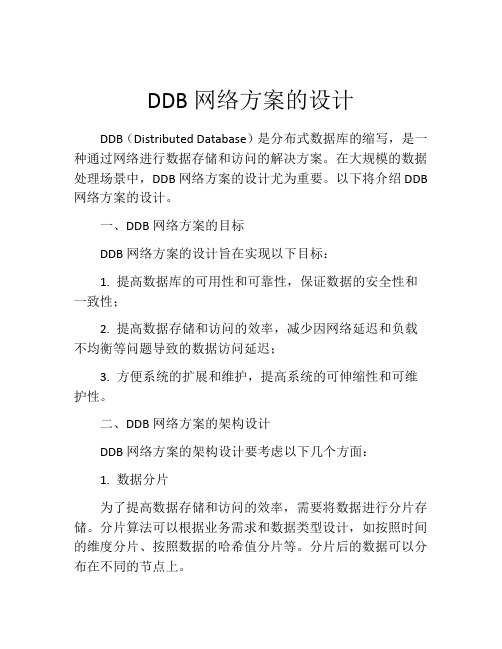
DDB网络方案的设计DDB(Distributed Database)是分布式数据库的缩写,是一种通过网络进行数据存储和访问的解决方案。
在大规模的数据处理场景中,DDB网络方案的设计尤为重要。
以下将介绍DDB 网络方案的设计。
一、DDB网络方案的目标DDB网络方案的设计旨在实现以下目标:1. 提高数据库的可用性和可靠性,保证数据的安全性和一致性;2. 提高数据存储和访问的效率,减少因网络延迟和负载不均衡等问题导致的数据访问延迟;3. 方便系统的扩展和维护,提高系统的可伸缩性和可维护性。
二、DDB网络方案的架构设计DDB网络方案的架构设计要考虑以下几个方面:1. 数据分片为了提高数据存储和访问的效率,需要将数据进行分片存储。
分片算法可以根据业务需求和数据类型设计,如按照时间的维度分片、按照数据的哈希值分片等。
分片后的数据可以分布在不同的节点上。
2. 数据复制为了保证数据的安全性和可靠性,在分布式环境中需要将数据复制到多个节点上。
数据的复制可以采用同步或异步方式进行。
同步方式对数据的一致性要求更高,但会增加访问延迟;异步方式则会降低数据的一致性,但可以提高数据的访问效率。
3. 负载均衡为了避免某一节点负载过高,导致数据访问速度变慢或节点崩溃的情况发生,需要对节点进行负载均衡。
负载均衡可以根据节点的性能和负载情况进行调度,将访问请求分配到不同的节点上,从而避免节点负载过高的情况发生。
4. 数据访问数据访问可以通过客户端访问或者API接口进行。
客户端可以是Web应用程序或者移动应用程序等。
API接口可以提供查询、插入、更新和删除等操作。
5. 数据治理在大规模的数据处理场景中,需要对数据进行治理,包括数据安全、权限管理、数据备份等。
同时需要对数据进行监控和日志管理,确保数据的安全和一致性。
三、DDB网络方案的应用场景DDB网络方案可以应用于以下场景:1. 互联网应用在互联网应用中,需要处理大量的数据访问请求,同时保证数据的安全性和一致性。
Neutron L3讲解

qg-XXX
brcps
br-tun
br-tun
brcps
trunk0 eth0 eth1
tunnel_bearing
tunnel_bearing
trunk0 eth0 eth1
switch
vlan 101 vlan 102
1. L3基础概念 2. 集中式路由
2.1 概念模型 2.2 流量走向
1. L3基础概念 2. 集中式路由
2.1 概念模型 2.2 流量走向
3. 分布式路由
3.1 概念模型 3.2 流量走向
4. 浮动IP
4.1 概念模型 4.2 流量走向 4.3 公有云场景
L3基础概念
L3即vrouter,主要功能是连接租户内同一network或不同 network之间的子网,以及连接内外网(FIP/SNAT)。前者是数据 中心内部虚机之前的通信,成为东西向流量。后者是虚机与外 部通信,称为南北向流量。vrouter分为两种模式:集中式,分 布式。集中式指的是vrouter实例化在network节点,compute节 点不实例化vrouter,当两个不同子网的vm通信时,流量需要在 network节点上的vrouter做一次三层转发,走两次隧道。分布式 指的是vruoter实例化在所有compute节点,三层转发的功能在 本节点的vrouter实例中完成。从而只需要走一次隧道。
qbrXXX
qbrXXX
br-int
network node
每个network对应 一个命名空间
qdhcp-XXX
每个router对应一个命 名空间qrouter-XXX
dnsmas q
tapXXX
qrXXX qrXXX qgXXX
计算机网络原理填空题及答案

计算机网络原理填空题及答案本页仅作为文档封面,使用时可以删除This document is for reference only-rar21year.March计算机网络原理填空题1. 10BASE-T标准规定的网络拓扑结构是星型,网络速率是10Mbps,网络所采用的网络介质是双绞线,信号是基带。
2.常用的网络操作系统有windowsNT、Netware和Unix。
3. 国内最早的四大网络包括原邮电部的ChinaNet、原电子部的ChinaGBN、教育部的CERnet (或中国教育科研网)和中科院的CSTnet。
4. 在TCP/IP中,负责将IP地址映像成所对应的物理地址的协议是ARP地址解析协议。
5. 中采用的物理层协议标准是。
6. 物理层主要描述传输介质接口的机械特性、电气特性、功能特性和规程特性。
7. 根据通信站在物理链路中的功能特点,高级数据链路控制规程把通信站分为主站、从站和组合站三类。
8. 通信控制规程可分为两大类,即面向字符型和面向位型。
9. 会话层的基本功能是向表示层提供建立和使用连接的方法。
10. TCP/IP 是当今网络互连的核心协议,它的最主要目标是实现网络互连。
11.局域网通信选用的通信媒体通常是专用的同轴电缆、双绞线和光纤。
12. 目前的局域网操作系统按其功能可划分为对等模式、文件服务器模式和客户机/服务器模式。
13. 在Windows NT Server安装完毕后,自动内置两个用户帐号是:Administrator 和Guest。
14. 将Internet技术应用于企业内部管理的网络技术是Intranet(内联网)技术。
15.从介质访问控制方法的角度,局域网分为共享介质局域网和交换式LAN网。
16. DNS服务器(DNS服务器有时也扮演DNS客户端的角色)向另一台DNS服务器查询IP地址时,可以有3种查询方式:递归型、循环型和反向型。
17.计算机网络的主要功能为硬件资源共享、软件资源共享、用户间的信息交换。
- 1、下载文档前请自行甄别文档内容的完整性,平台不提供额外的编辑、内容补充、找答案等附加服务。
- 2、"仅部分预览"的文档,不可在线预览部分如存在完整性等问题,可反馈申请退款(可完整预览的文档不适用该条件!)。
- 3、如文档侵犯您的权益,请联系客服反馈,我们会尽快为您处理(人工客服工作时间:9:00-18:30)。
EMP
L1
Eno, Ename, Title
L2
ASG
L3
Eno, Jno, Resp, Dur
L3-1 DDBS Design -- 14
HF -Appl. Info. : Simple Predicates
Predicates used in user queries.
Given R(A1 , A2 , ..., An ), with each Ai having domain of values Di Simple predicate pj defined on R has the form
User Input
LIS’s
L3-1 DDBS Design -- 5
Distribution Design Issues
Fragmentation
Why fragmentation at all How to fragment How much to fragment How to test correctness
Not-replicated
Each fragment reside at only one site
What
are the advantages and disadvantages?
L3-1 DDBS Design -- 10
Allocation Alternatives: Pros and Cons
L3-1 DDBS Design -- 4
Top-Down Design Process
User Input
Requirement Analysis
Objectives
User Input
Conceptual Design GCS
View Integration
View Design ES’s
Access Information Distribution Design LCS’s Physical Design
L3-1 DDBS Design -- 11
Information Req源自irements Four
categories
Database information.
Application information. Communication network information.
Computer system information.
Disjointness
If relation R is decomposed into fragments R1, R2, …, Rn
and data item di is in Rj, then di should not be in any other fragment Rk (k!=j).
– Mixed/Hybrid Fragments -combination of above two.
How
much to fragment
Too little -too much of irrelevant data access. Too much -too much processing cost. Need to find suitable level of fragmentation.
priority.
L3-1 DDBS Design -- 2
Dimensions of the Problem
Access pattern behavior
Dynamic Static Complete Information
Data Data + Program Level of knowledge Partial Information
L3-1 DDBS Design -- 9
Allocation Alternatives
Full
Replication.
Replication (Partitioned)
Each fragment reside at each site
Partial
Each fragment reside at some of the sites
L3-1 DDBS Design -- 13
HF -Database Information
The global schema
PAY Title, Sal
Owner and member relations
Cardinality of each relation
PROJ Jno, Jname, Budget. Loc
Full-Replication Partial -replication Partitioning Query Processing Directory Management Concurrency Control Reliability Reality Easy Easy or non-existent Moderate High Possible application Same Difficulty Same Difficulty Difficult High Realistic Easy Low Possible application
is an operator =, <, >, , , and ; Value Di
Pj : Ai Value
Example:
Jname=“maintenance” Budget 200000
Follow ``80/20'' rule
L3-1 DDBS Design -- 15
L3-1 DDBS Design -- 7
About fragmentation
How
should we fragment
Vertical Fragments -sub grouping of the attributes. Horizontal Fragments -sub grouping of the tuples.
HF -Appl. Info. : Minterm Predicates
Given a set Pr = {p1, p2, ..., pm} of simple predicates for relation Ri , the set of minterm predicates M = {m 1, m 2 , ..., m z } defined as
L3: DDBS Design
1. 2.
Introduction Fragmentation
1) Horizontal fragmentation
2) Vertical fragmentation
3.
Allocation
L3-1 DDBS Design -- 1
Distributed Database Design
the distribution of DDBMS software distribution of applications
We
concentrate on distribution of data.
The distribution of DDBMS and applications are given a
L3-1 DDBS Design -- 12
Horizontal Fragmentation (HF)
Primary
horizontal fragmentation (PHF) based on predicates accessing the relation. Derived horizontal fragmentation (DHF) based on predicates being defined on another logically related relation. We shall first study algorithm for horizontal fragmentation, and then study issues related to derived horizontal fragmentation.
Allocation Information
requirements
L3-1 DDBS Design -- 6
Why fragment at all?
Unit
of distribution = unit of data application accesses. Reduce irrelevant data access. Facilitates intra-query concurrency. Can be used with other performance enhancing methods, such as, indexing and clustering Applications have conflicting requirements making disjoint fragmentation very hard problem. Multiple fragment access requires join or union. Semantic data control (integrity enforcement) could be very costly.
L3-1 DDBS Design -- 8
Correctness Criteria
Completeness
-no loss of data.
Decomposition of relation R into fragments R1, R2, …, Rn
is complete if and only if each data item in R can also be found in some Ri .
